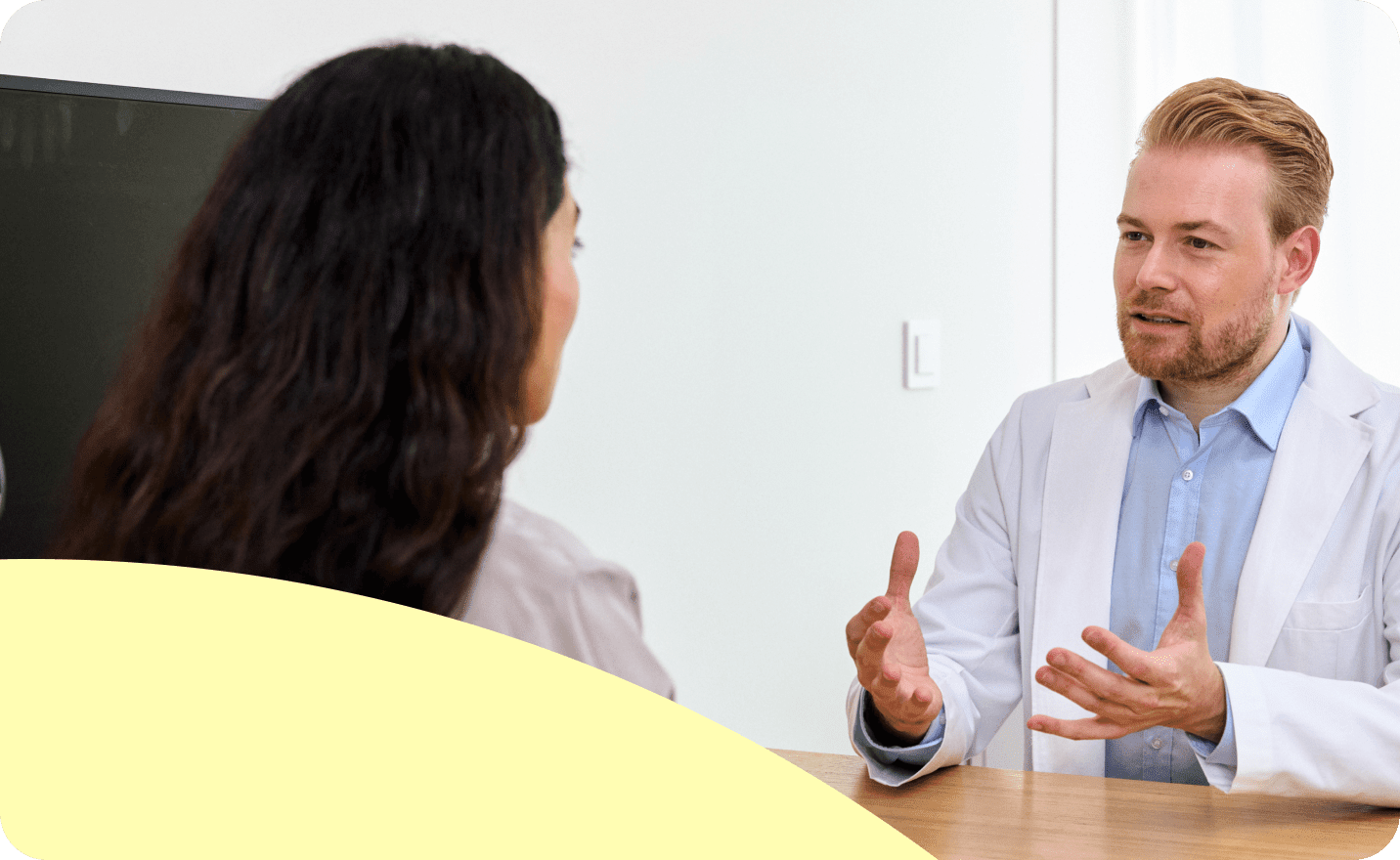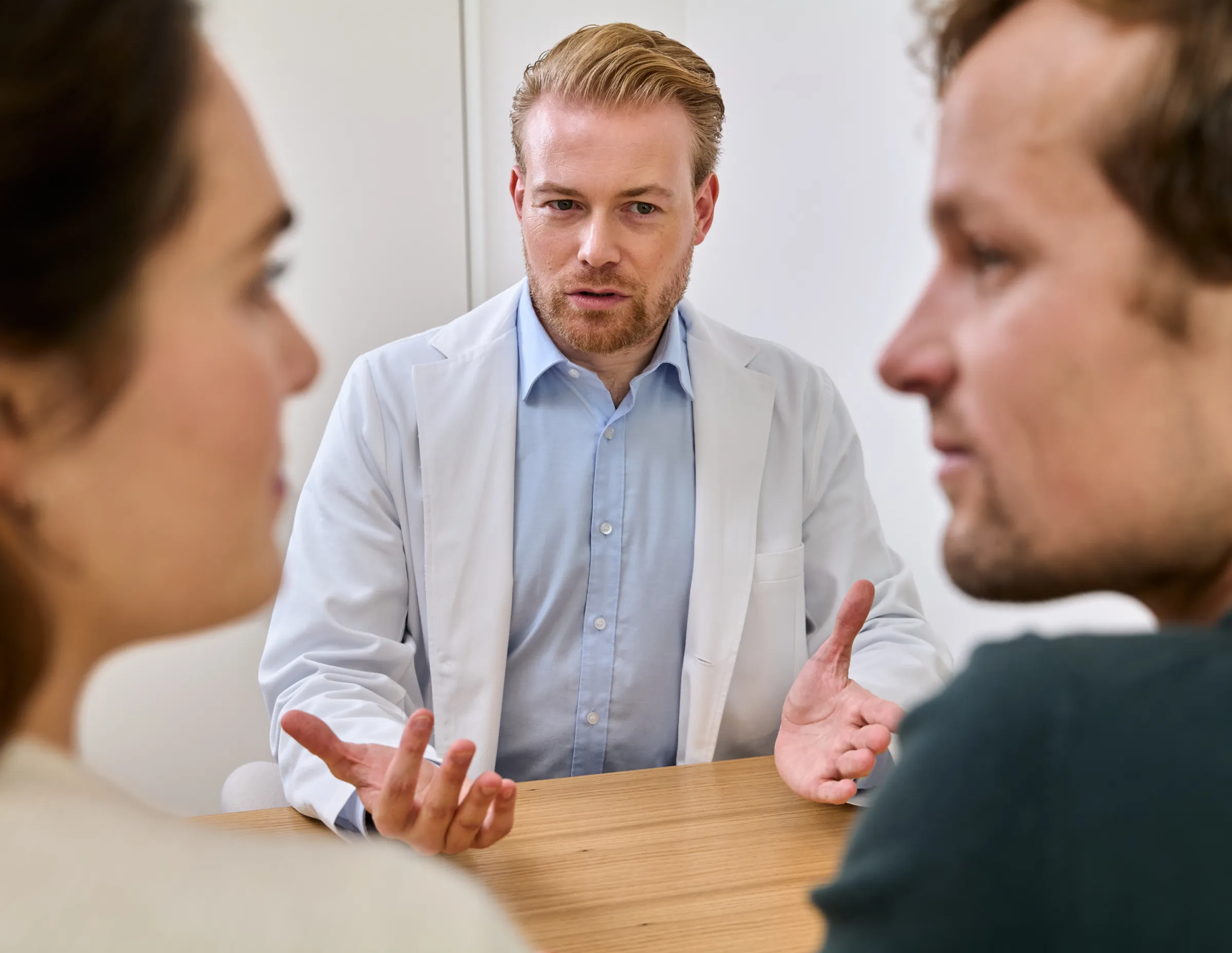Learn about endometriosis, from symptoms and complications to causes and diagnosis.
Do you suspect that you or your partner have endometriosis? Do you want to know more about the condition? Here, we explain what endometriosis is, from symptoms and complications to causes and diagnosis. You’re not alone, and getting the right advice and treatment will help you gain control of the condition.
What is endometriosis?
Endometriosis is a complex, estrogen-dependent medical condition in which tissue similar to the lining of the uterus (the endometrium) is found outside the uterus. It is most often found in the pelvic region. In extremely rare cases, this tissue also finds it way to other parts of the body, such as the lungs, liver, and spleen.
The endometrial-like tissue can attach to the ovaries, fallopian tubes, bladder, bowel, and peritoneum (the tissue lining the abdominal cavity). The tissue establishes a blood supply and grows to form lesions or implants. Adhesions, which are scar tissue caused by these lesions, also develop between the tissues and organs in the pelvic region.
The displaced endometrial-like tissue behaves as if it is still in the uterus. It therefore, thickens, breaks down and ‘bleeds’ in response to the hormonal fluctuations during the menstrual cycle. This causes chronic inflammation and pain, which can be debilitating for a woman suffering from the condition.
Women with endometriosis experience a variety of symptoms, varying in severity. Infertility is often a major issue of the condition. Tubal pregnancies (the most common form of an ectopic pregnancy), miscarriages, and preterm births have all been reported in cases of endometriosis. Therefore, it is highly important that a woman gets a full diagnosis and is offered a comprehensive treatment strategy.
Who does it affect?
It is estimated that 6-18% of women of reproductive age suffer from endometriosis. In a US study, 6.1% of 48,020 women surveyed had diagnosed endometriosis, with over half receiving their diagnosis between 18–29 years of age. Most of these women (86.2%) had experienced symptoms before diagnosis. However, reported values vary, possibly because diagnosis and access to proper healthcare is limited for many women around the world. While it most commonly affects women between the age of 30–40, it can appear as early as when menstruation begins.
What causes endometriosis?
This is a good question that unfortunately lacks a clear answer. For many years, scientists have tried to determine why endometriosis occurs. Several theories have been proposed and are still being debated:
- Retrograde menstruation theory. Dating back to the 1920s, this theory suggests that endometrial tissue migrates in a retrograde (backwards) manner from the uterus through the fallopian tubes and into the pelvic cavity. This is believed to occur when there is so much menstrual blood loss that the blood overflows into and our of the fallopian tubes instead of exiting through the cervix.
- Coelomic metaplasia and Mullerian remnants hypothesis. This theory, which is a mouthful to say, considers that specialised cells develop into the wrong type of cells or migrate to the wrong place. For example, peritoneal cells become endometrial-like cells. Alternatively, endometrial cells may migrate to the abdomen during early development.
- Hematogenous and lymphovascular spread theory. This theory suggests that during a heavy menstrual flow, endometrial cells migrate into the blood system and/or the lymphatic system and travel widely through the body. This could explain the rarer forms of endometriosis where the endometrial-like tissue is found in remote regions away from the uterus, such as the lung, spleen, liver, heart.
- Stem cell theory. Usually, stem cells (cells that have the ability to turn into any cell within the body) that come from bone marrow travel to the uterus and then develop into endometrial cells. However, perhaps the problem occurs when these cells don’t make it to the uterus and develop into endometrial-like cells outside the uterus.
- Genetic aetiology theory. Endometriosis is likely to involve a multitude of genes. To date, there is no distinct hereditary pattern linked with the condition. However, various studies show that female family members are at a higher risk (approximately 51%) of also suffering from the condition if there is a family member with confirmed endometriosis. This suggests that genetic factors may play a role.
- Epigenetic theory. Epigenetics is a field of research that explores how our genes can be influenced or altered by environmental or behavioural factors. Although you have a certain genetic code (your DNA), these outside factors may cause your genes may be expressed or suppressed differently. In recent years, epigenetic studies are shedding more light on conditions like endometriosis. Some genes are coming under question for endometriosis and are further discussed here.
What are the risk factors for endometriosis?
Risk factors for endometriosis include
- Family history: your risk of developing endometriosis is 7-10 time more likely if you have a grandmother, mother or sister (first-degree relative) with confirmed endometriosis.
- Characteristics of your menstrual cycle: if your cycles are shorter than the average 28 days, if you started your periods before the age of 12, or if your periods last for more than the average of 4-5 days, you have a higher risk of developing endometriosis.
- Menstrual flow obstruction: if you suffer from uterine abnormalities such as excessive blood loss, uterine fibroids blocking the cervix or vagina, structural abnormalities of the cervix or vagina; then there is an increase risk of endometriosis. This supports the retrograde theory for the development of endometriosis.
Alternatively, pregnancy, menopausal status, multiple births, and prolonged time breast feeding are suggested to be protective factors.
What are the common symptoms of endometriosis?
Every woman is different; your experience with endometriosis may be completely different from someone else suffering from the condition. Symptoms can be broad and they may vary in severity. They can also appear at different stages in life.
Commonly reported symptoms of endometriosis include
- Chronic pelvic pain
- Irregular and painful periods (dysmenorrhea)
- Pain during or after sexual intercourse (superficial dyspareunia)
- Pain during bowel movements and/or urination
- Abdominal bloating
- Nausea, diarrhoea, constipation
- Fatigue
- Pain in other body regions during the menstrual cycle
- Mental health issues: depression, anxiety, low self-esteem
- Decreased quality of life
- Infertility
It is also possible to have no symptoms and endometriosis is only discovered when a women starts trying to get pregnant. In this case, endometriosis may be discovered during fertility testing.
Classifying endometriosis
Endometriosis is classified either by stages or categories. The stages range from minimal to severe, whereas the categories place more emphasis on location. Your doctor may use both or one of these approaches to explain what level of endometriosis they believe you are experiencing.
Stages of endometriosis
The American Society of Reproductive Medicine (ASRM) classified endometriosis into four stages. These are:
- Stage I (1–5 points): Minimal, with few minimal implants
- Stage II (6–15 points): Mild, with more or deeper implants
- Stage III (16–40 points): Moderate, many implants, small cysts on one or both ovaries, and the presence of adhesions
- Stage IV (> 40 points): Severe, many deep implants, large cysts on one or both ovaries, many dense adhesions
The point system represents the size of the lesions and if they are deep or superficial, and the number of adhesions and if the scarring is minimal or dense. It should be noted that these stages do not necessarily reflect the presence of symptoms. This system was originally designed to predict fertility outcomes.
Categories of endometriosis
The Endometriosis Foundation of America has advanced these stages to create categories that describe the condition based on where it is located in the body:
- Category I: Peritoneal endometriosis. The most minimal form where the endometrial tissue migrates only into the peritoneal cavity.
- Category II: Ovarian endometriomas (also known as chocolate cysts). The endometriosis appears in the ovaries.
- Category III: Deep infiltrating endometriosis I (DIE I). This describes cases where the endometriosis has spread to the pelvic cavity, which can include the uterus, fallopian tubes, ovaries, rectum.
- Category IV: Deep infiltrating endometriosis II (DIE II). This covers the more extreme cases where it affects in and outside the pelvic cavity. This includes the bowels, appendix, heart, lungs, diaphragm, and in rare cases the brain.
Does endometriosis cause infertility?
Infertility is the most common complication of endometriosis. It is reported that about one-third of women with endometriosis will experience infertility. This is almost twice the rate of women who do not have the condition.
In couples without medical conditions, the monthly fertility rate (defined as the probability of a woman achieving a live birth for any given month) ranges between 15-20%, while women with untreated endometriosis have a 2-10% monthly fertility rate. However, this data is somewhat outdated and rates could be more. There are multiple reasons for this:
- Pain during or after intercourse: pain during sex is a common complaint for women with endometriosis. If you are trying to get pregnant, but pain is hindering you from performing full penetrative intercourse, then pregnancy will not happen.
- Pelvic adhesions: the endometrial adhesions may occur around the uterus, ovaries, fallopian tubes, bladder, ureter and bowel. The adhesions can affect conception by impairing egg release from the ovary (ovulation), cause abnormalities in the uterus itself, or block the fallopian tubes and prevent fertilisation.
- Inflammation: the more inflammation, the more hostile the environment is. The toxic inflammatory response has a negative effect on various bodily functions that could affect conception. Excessive inflammatory responses can affect egg production, block ovulation, affect the health and function of sperm when in the uterus and fallopian tubes, and prevent implantation.
- Altered ovulation and egg production: the cysts within the ovary (endometriomas) can affect both egg production, ovulation, and ovarian reserve (the natural amount of eggs a women has in her ovaries). In addition, women who have undergone surgery to remove lesions or adhesions around the ovary may have a lower ovarian reserve due to damage to the ovary. Reduced ovulation will impact the chances of conceiving.
- Impaired implantation of the mature egg (ovum) into the endometrium: hormones control the thickness of the endometrium in the uterus, preparing it each month for an egg to implant and become an embryo. If there are hormonal imbalances caused by the endometriosis, the endometrium may not develop or be able to receive the egg and allow it to grow.
If your fertility is being affected by endometriosis, it’s a good idea to speak to your gynaecologist or fertility specialist.
How to get a firm endometriosis diagnosis?
Endometriosis is difficult to diagnose because it presents in many different ways. Getting a diagnosis can take several years, as many symptoms are put down to being a ‘painful period’ or conditions like irritable bowel syndrome. It is also possible to not have any symptoms of endometriosis; if this is the case, it may only be discovered during fertility testing. Ways your doctor will detect endometriosis:
History of health and symptoms: talking and explaining your symptoms to a doctor can guide them in understanding your health condition. Keeping a diary of periods and symptoms can offer a great deal of insight into the condition. It is also a good idea to let them know how long you have been experiencing infertility. They will also ask about any family history of gynaecological issues, any surgery or previous illnesses e.g. autoimmune diseases.
Pelvic exam: although your doctor will perform a pelvic exam, it is difficult to detect and localise endometriosis. This may only be possible if lesions and adhesion are present at the cervix, on the ligaments surrounding the uterus or between the vagina and rectum.
Imaging tests: doctors will often perform a transvaginal ultrasound (an ultrasound that is viewed from your cervix) to visualise your inner anatomy. However, this will only pick up on lesions within the uterus and ovaries. They may go further and do an MRI (magnetic resonance imaging), which can detect very small lesions and any benign (noncancerous) masses. However, due to the cost of MRI, they may prefer ultrasound.
Laparoscopy: the gold standard diagnosis method for endometriosis is laparoscopic surgery (or laparoscopy). Laparoscopy is a small surgical procedure that involves a small incision in the abdomen just below the belly button. A specially trained doctor will insert a tube with a camera attached to the end (a laparoscope) through the incision. This allows them to explore the abdominal and pelvic cavity and visualise the location and extent of the lesions and adhesions. The doctor can then rate the lesions and adhesions according to the stages and categories described above.
During the laparoscopy, the doctor may also perform a biopsy (remove a tissue sample) of the lesions or endometrium to test for abnormal cells or the type of cells.
Laparoscopy is an invasive procedure, and doctors will not recommend it to everyone. If doctors suspect endometriosis before the laparoscopy, they may try to remove the lesions during the procedure to help alleviate the pain and symptoms. Your doctor will discuss this procedure thoroughly with you.
Ruling out other conditions: for the doctor to give a confirmed diagnosis of endometriosis, they need to rule out other conditions that could cause similar symptoms, such as pelvic inflammatory disease (PID), ovarian cysts, ectopic pregnancy, irritable bowel syndrome, uterine fibroids etc. They may run additional tests to test for these conditions.
Treatment options for endometriosis
Symptoms of endometriosis can be debilitating. The early you get a diagnosis and discuss treatment, the better. Getting the condition under control is key, especially if you wish to conceive, but unfortunately, there is no known cure for the condition.
The treatment of endometriosis depends on the symptoms that are being targeted and if you are trying to become pregnant. In some cases, the focus may be primarily on pain reduction, while in others, restoring normal fertility may be the primary goal. When following any mode of treatment, it is advised to keep a track of your symptoms, menstrual cycle, and fertility.
- Pain relief: as pain is the most common symptom and is often chronic (long-term), medications for pain relief may be prescribed. It important to use medication that is safe for long-term use. This may be non-steroidal anti-inflammatory drugs (ibuprofen) or pain relief like paracetamol.
- Hormonal therapy: medications that targets hormonal imbalances may be prescribed to help deal with extremely painful periods and other endometriosis symptoms. There are various forms the doctor may offer; some reduce estrogen levels, such as gonadotropin-releasing hormones (GnRH) agonists or aromatase inhibitors. Others increase progesterone levels, such as oral contraceptives (birth control).
The combined oral contraceptive pill (estrogen and progesterone)has been used for many years as a therapy to reduce endometriosis-associated pain. The pill typically has minimal side effects and there are a variety of drug types that you can try to find the one that works best for you (your doctor can explain this option further). In addition, women can try progesterone-only therapy (also known as progestins), which help women who have side effects when taking estrogen. It is also possible that a doctor may suggest a combination of different therapies.
Many of these therapies come in oral, skin patches, vaginal rings, subcutaneous (placed under the skin), or as intrauterine device (a small device placed inside the uterus). Having various forms, doses and ways to deliver the therapy is useful, so you and your doctor can find one that best suits you. However, these hormone therapies will likely cause amenorrhoea (no periods) and prevent ovulation. For this reason, they are less suitable for women trying to conceive. - Surgery: A doctor may suggest to perform a laparoscopy, firstly to diagnose and localise the endometrial lesions and then to remove or laser the lesions or adhesions. This should help to alleviate the pain and symptoms and restore normal ovulation and periods. Unfortunately, the lesions can reappear, and the procedure may need to be repeated after a few years.
- Pregnancy related therapy: as well as a diagnostic and surgical laparoscopy, a doctor may suggest hormonal treatments in combination with assisted reproduction. For example, they may suggest using hormonal medication to induce ovulation and help eggs mature. This can be combined with intrauterine insemination (IUI) or in vitro fertilisation (IVF). For women under age 35, ovulation induction alone may be offered first. For women over the age of 35, it is advised to use the combination of ovulation induction and IUI or IVF as a first-line treatment.
- Alternative therapies: women can also try alternative therapies that do not require medication or surgery, such as acupuncture, herbal medicines, diet and exercise regimes. These strategies may help you naturally conceive with endometriosis.
Takeaway
Endometriosis is a debilitating condition that can dramatically reduce a woman’s quality of life, and physical and mental well-being. It is important to get a clear diagnosis and speak with a specialised doctor to understand the severity of the condition. Upon knowing that, you can be given the care and treatment needed to try to get the condition under control, especially if you wish to get pregnant in the future. Try to track your symptoms, menstrual cycle and effects of any treatment you’re taking, to work out what is influencing the condition.
If endometriosis and infertility is affecting you, book an appointment with Cada’s trained and compassionate fertility specialists, and we can help you on your journey. Reserve your spot for a personalised consultation today.







